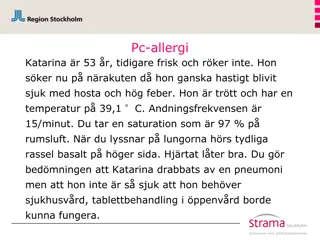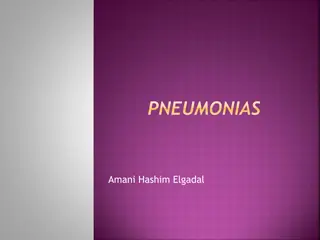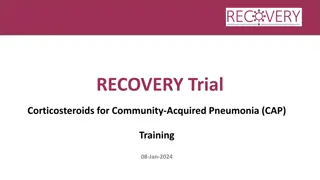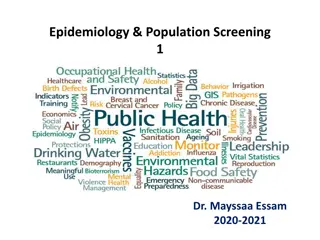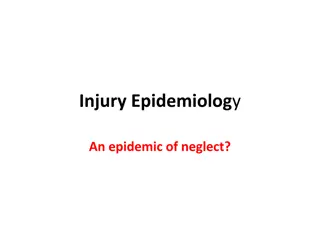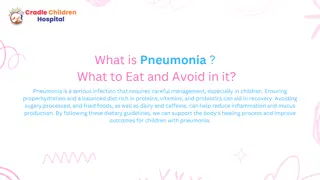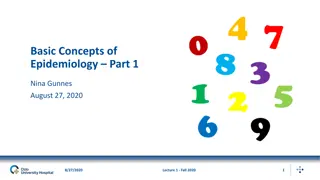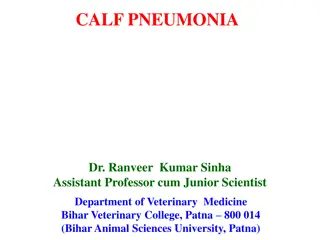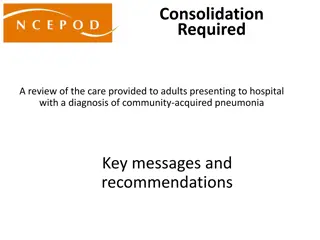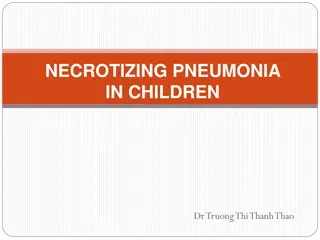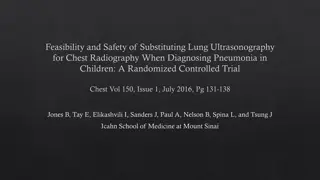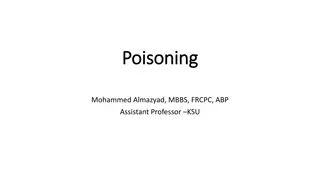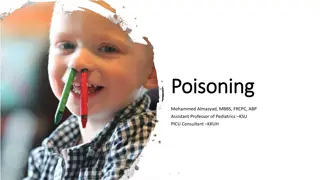Comprehensive Overview of Pneumonia: Causes, Epidemiology, and Management
Pneumonia is an inflammatory lung condition that can be caused by viruses, bacteria, or other microorganisms. It affects millions of people worldwide, with a significant impact on newborn infants. The presentation covers the definition, epidemiology, types, etiology, risk factors, and management of pneumonia, providing valuable insights into this respiratory illness.
Download Presentation

Please find below an Image/Link to download the presentation.
The content on the website is provided AS IS for your information and personal use only. It may not be sold, licensed, or shared on other websites without obtaining consent from the author.If you encounter any issues during the download, it is possible that the publisher has removed the file from their server.
You are allowed to download the files provided on this website for personal or commercial use, subject to the condition that they are used lawfully. All files are the property of their respective owners.
The content on the website is provided AS IS for your information and personal use only. It may not be sold, licensed, or shared on other websites without obtaining consent from the author.
E N D
Presentation Transcript
PRESENTATI ON ON PNEUMONIA
0bjective Intruduce the pneumonia Define the pneumonia Discuss the epidemiology Explain the types. Listout the risk factor Discuss the etiology Discuss the transmission Explain the pathophysiology Describe the management
INTRODUCTION Pneumonia is an inflammatory pulmonary process that may originate in the lung or be a focal complication of a contiguous or systemic inflammatory process. Abnormalities of airway patency as well as alveolar ventilation and perfusion occur frequently due to various mechanisms. These derangements often significantly alter gas exchange and dependent cellular metabolism in the many tissues and organs that determine survival and contribute to quality of life.
DEFINITION Congenital Pneumonia is an inflammatory condition of the lung affecting primarily the microscopic air sacs known as alveoli at birth. It is usually caused by infection with viruses or bacteria and less commonly other microorganisms, conditions such as autoimmune diseases. Such pathologic problems, superimposed on the underlying difficulties associated with the transition from intrauterine to extrauterine life, pose critical challenges to the immature human organism. certain drugs and other
EPIDEMIOLOGY- In 2008, pneumonia occurred in approximately 156 million children (151 million in the developing world and 5 million in the developed world) The World Health Organization estimates that one in three newborn infant deaths is due to pneumonia. Neonatal pneumonia ranges from 20 to 32 percent of live-born and from 15 to 38 percent of stillborn infants. congenital pneumonia accounted for 30 of these 56 infections, caused by maternal enteric organisms frequently accompanies chorioamnionitis.
TYPES Morphology- Lobar pneumonia Bronchopneumonia Interstitial pneumonia Onset True congenital pneumonia Intrapartum pneumonia Postnatal pneumonia
Etiology Viral Bacterial Mycoplasmal Aspiration
RISK FACTOR- Unexplained preterm labour. Rupture of membranes before the onset of labour Membrane rupture more than 18 hours before delivery smelling amniotic fluid
Infection of the maternal genitourinary tract. Previous infant with neonatal infection. Nonreassuring fetal well-being test results Fetal tachycardia Meconium in the amniotic fluid
ETIOLOGY- Congenital pneumonia may be infectious Group B Streptococcus (GBS) Nontypable Haemophilus influenzae Listeria monocytogenes Enterococci Staphylococcus aureus
Noninfectious- pneumonia are a class of diffuse lung diseases. They include: diffuse alveolar damage, organizing pneumonia, nonspecific interstitial pneumonia,Aspiration desquamative interstitial
transmission Haematogenous- Mom with bacterial or viral(micro organisms) accumulation in blood. Ascending -Ascending infection from the birth canal Aspiration- Aspiration of infected or inflamed amniotic fluid
h o r r pathophysiology e l a t i v e l y s h o r t l y b e f o r e Due to the etiological factors If the mother has a bloodstream V infection defenses are limited in foetuses can readily cross the placental barrier
dissemination and illness may result before birth or relatively shortly before birth pneumonia is already established at birth
LABORATORY INVESTIGATION Complete Blood Count White Blood Cell Count (5000- 25000) Inflammation markers CRP, Procalcitonin, cytokines Culture The most useful laboratory tests for congenital pneumonia facilitate the identification of an infecting microorganism. Results can be used for therapeutic decisions as well as prognostic and infection control considerations. Arterial Blood Gas Indicated for S/S of Hypoxia
TREATMENT- RESPIRATORY SUPPORT- Adequate gas exchange depends not only on alveolar ventilation, but also on perfusion and gas transport capacity of the alveolar. Airway patency Gentle vibration and percussion is used in some centers to mobilize the secretions. Deep suctioning should be avoided because it can cause airway trauma and swelling, which, in turn, may cause large airway obstruction. Use of mucolytic agents Ventilatory support may be rendered unusually challenging by alveoli with variable degrees of inflation from the unpredictable distribution of surfactant inactivation, partial airway obstructiion
OTHER SUPPORTIVE MEASURES- Red blood cells should be administered to achieve a hemoglobin concentration of 13-16 g/dL in the acutely ill infant, to ensure optimal oxygen delivery to the tissues Delivery of adequate amounts of glucose and maintenance of thermoregulation, electrolyte balance, and other elements of neonatal supportive care are also essential.
Nutrition: Attempts at enteral feeding often are withheld in favor of parenteral nutritional support until respiratory and hemodynamic status is sufficiently stable. Transfer (If no facilities)stabilize the neonate and transfer to a tertiary care neonatal intensive care unit.
MEDICATION- ANTIBIOTICS & ANTVIRALS- Primary Antibiotic Protocol Ampicillin 50 mg/kg/dose IV or IM q12 hours Cefotaxime 50mg/kg IV or IM q12h Erythromycin 30-50 mg/kg/d PO divided Q8H Gentamicin 2.5 mg/kg/dose IV/IM Q24H Antiviral agents acyclovir (Zovirax) Acyclovir treatment should be considered when a diagnosis of herpes simplex virus is suspected and when the infant is not responding to antibiotic therapy.
COMPLICATION- Restrictive pleural effusion Infected pleural effusion Empyema. Persistent pulmonary hypertension of the newborn. Air leak syndrome, including pneumothorax, pneumomediastinum, pneumopericardium, and pulmonary interstitial emphysema Airway injury. Obstructive airway secretions. Chronic lung disease.
13.PREVENTION- -Premature delivery Membrane rupture more than 18 hours before delivery. Intrapartum fever. Group B streptococcal bacteriuria. History of previous infant with early-onset neonatal group B streptococcal infection. Prevention strategies may include antepartum and intrapartum broad-spectrum antibiotic treatment in mothers with preterm rupture of membranes or in whom chorioamnionitis is suspected.
In the presence of particulate amniotic fluid meconium, suction the trachea immediately after birth if the infant is not vigorous. Currently, there is little evidence demonstrating the potential efficacy of the following interventions in neonates: Elevating the head..
PARENT EDUCATION Education of parents whose infant has had congenital pneumonia is principally directed toward subsequent care. Counsel parents regarding the need to prevent exposure of infants to tobacco smoke. Educate parents regarding the benefit infants may receive from pneumococcal immunization and annual influenza immunization. Discuss potential benefits and costs of respiratory syncytial virus immune globulin. Educate parents regarding later infectious exposures in daycare centers, schools, and similar settings and the importance of hand washing.
NURSING DIAGNOSIS Impaired Gas Exchange (cyanosis ,irritability, nasal flaring,tachycardia) Ineffective Breathing Pattern (nasal flaring Altered body Temperature [Fever, cold and clammy skin. Altered Nutrition:less than body requirements
SUMMARY Pneumonia is an infection that inflames the air sacs in one or both lungs. The air sacs may fill with fluid or pus (purulent material), causing cough with phlegm or pus, fever, chills, and difficulty breathing. A variety of organisms, including bacteria, viruses and fungi, can cause pneumonia.
BIBLIOGRAPHY Ghai, O.P. (2008).Ghai essentials of paediatrics.(ed.6th).Delhi. O.P Ghai publishers. Gupta,P.(2004).Essentials of paediatric nursing.(ed.1st).New Delhi:A.P Jain &Co Publishers. Marlow.& Redding.(2008).Text book of paediatric nursing.(ed.6th).Philadelphia: Elsevier publications.P.NO.-57,58 Wong, D.L& Hockenberry.(2001).Wong s essentials of paediatric nursing.(ed.7th).Missouri: Mosby publications Parul Dutta, Paediatric nursing 2nd. edition P.No.23


